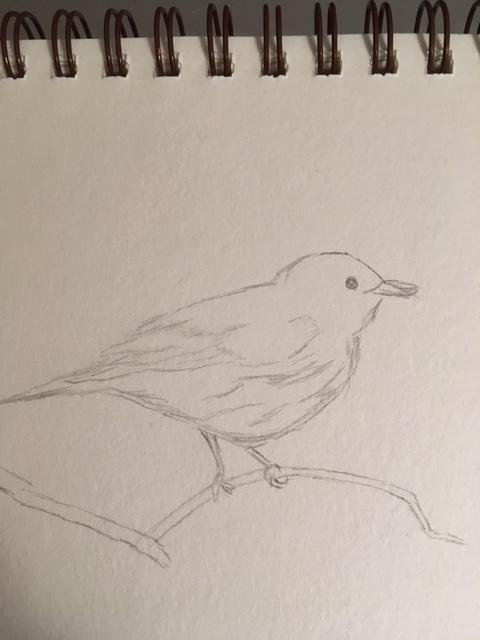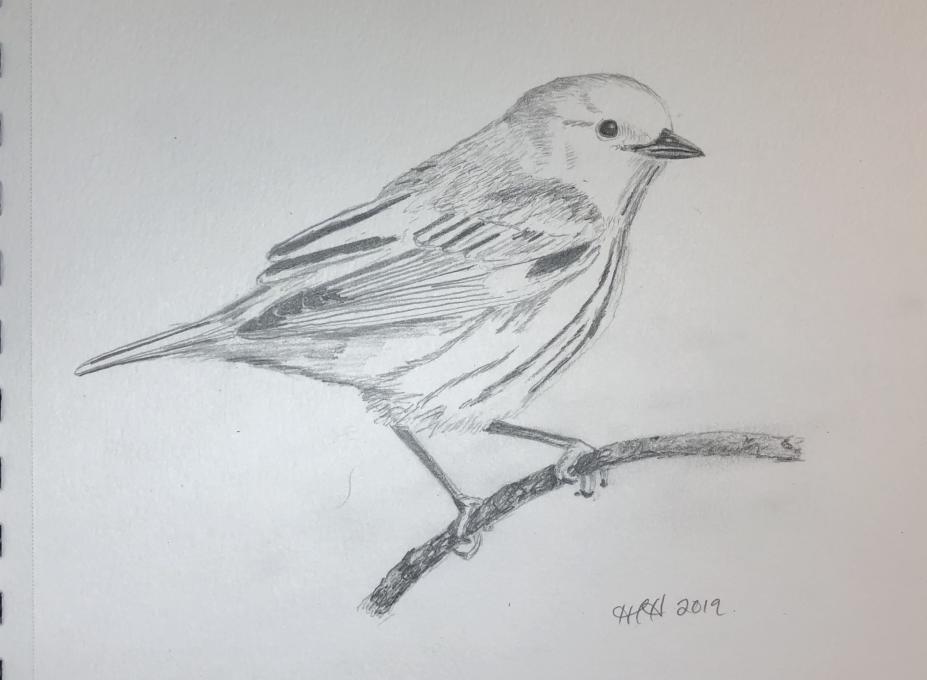The Cornell Lab Bird Academy › Discussion Groups › Nature Journaling and Field Sketching › Jump Right in!
-
 I am more comfortable drawing from a photo than real life. I felt pretty comfortable with my pencil sketch, but as I added watercolor I really felt like I didn't know how to do that.
In a photo you have all the time to go back and see what you might have missed. I finished, and then said, what's in the background, and then did the green wash. However, the photo shows a blurred background, and in nature you would have more detail to chose from.
I am more comfortable drawing from a photo than real life. I felt pretty comfortable with my pencil sketch, but as I added watercolor I really felt like I didn't know how to do that.
In a photo you have all the time to go back and see what you might have missed. I finished, and then said, what's in the background, and then did the green wash. However, the photo shows a blurred background, and in nature you would have more detail to chose from. -
1. I feel I have more control drawing from a photo. The shape came more or less easy but I am not familiar with working with watercolors, I smudged the eye.. 2. I wouldn't have noticed how lively the feet are

-
1 I'm wondering why it is much easier for me to accurately draw a birds head when the beak is pointed left than when it's pointed right. I'm curious if anyone else finds this challenging.
-
Are you right-handed? I think it’s a bit easier to work left to right following the natural arc of my hand as it moves across the page, so maybe it’s also easier to get the angles and proportions right moving from the tip of a beak toward the tail? Somehow when the bird faces to the right it feels more awkward.
-
-
I enjoyed just trying for my first time. It was an enjoyable experience for me. I am excited to do more.
-
I was excited to begin, but my mental drawing and actual drawing had almost no relationship to each other.
-
Don’t despair, this is just the beginning! I sure understand the sentiment though.
-
-
1. Easier to get details when the bird is still. Made notes to indicate color. really struggled with the bill and feet. 2. light and shadows. missed the red on the breast.

-

-
I love your comments...
-
@Tania Me too!
-
It never occurred to me to enlarge the screen for more details. My kids would only shake their heads. Love what you did.
-
-
1. Bill and head shape are difficult to get correct. 2. The tree gave a hint to the time of year. Once again I would not have paid attention to head shape and bill as well as field marks. All these things are important for journaling and identification. Birds in photos are not moving as in field.
-

-
i was able to reflect on last lesson, mosty on using geometric shapes in sketching. i can certainly use practice though.
-
 I didn’t mind drawing from a photo, but I tended to do a complete drawing vs a quick impression. I did like being able to enlarge an area of the photo and look at the details. I’d never be able to do that in the field. On the other hand I only had one point of view using the photo. In the field there would be more interplay with light, and field conditions versus a stagnant view. I agree with the poster that suggested putting a time limit on completing the sketch. This is going to be so much fun!!
I didn’t mind drawing from a photo, but I tended to do a complete drawing vs a quick impression. I did like being able to enlarge an area of the photo and look at the details. I’d never be able to do that in the field. On the other hand I only had one point of view using the photo. In the field there would be more interplay with light, and field conditions versus a stagnant view. I agree with the poster that suggested putting a time limit on completing the sketch. This is going to be so much fun!! -
Didn't think of doing detail drawings of parts...will keep this in mind for my next page...thanks.
-
@marie You’re welcome, Marie. I’m loving this course already. 😊
-
I forgot to draw details separately, as you did with the toes and eye! Now that really makes it look like a naturalists' journal. Well done! ( I'm going back to my drawing and add that in.) . Thanks for reminding me!!
-
-
I like drawing from photos to get details from the bird, butterfly or bug or whatever I'm drawing that you can't otherwise get from seeing it in the distance flitting across the sky. You can get general information from looking through binoculars or from a quick glance, such as distinguishing that this bird isn't a gold finch from seeing the absence of the black markings. With this photo I can see that the tree must be an old apple or fruit tree due to the shape of the leaves and the moss and lichen growing on the branch. Plus I can see that the leaves look to be well into the season because they are dark green and a couple leaves have pieces of leaf material missing as though a bug or something took a bite out of it.
 I have an old tree similar and I can get the information for a closer look at the actual branch to record a zoomed in section.
The zoomed in portion of the first part of the lesson is something new to me. I love that. I can get a really close look at my tree and make an enlarged drawing of it to add to the drawing.
I have an old tree similar and I can get the information for a closer look at the actual branch to record a zoomed in section.
The zoomed in portion of the first part of the lesson is something new to me. I love that. I can get a really close look at my tree and make an enlarged drawing of it to add to the drawing.
-
I like drawing from a photo because it gives me time to study perspective, posture & proportion. The 3 P's come hard for me. I have little serious drawing experience & almost no art education. I am learning, however, to use negative space. I doubt I'll ever have nature journals worthy of publication, but I hope to get to a point where while I'm reveling in nature, I can record what I see & not get totally frustrated in the process.

-
It is easier to draw birds from a photo than in the field. the silhouette is ok, but the eye and legs are not quite right. One challenge is detemining the hierarchy of markings (feather patterns) and shading, especially with pencil sketching. look forward to learning to use watercolours in the field.

-
- Set a time limit as I tend to spends hours on a single f]drawing need to ,earn to sketch and capture the essence . Perhaps create a new habit of using more gesture working from a photo is great for detail work but I can get lost in the detail,sometimes.

-
I tried so to get the moss on the main branch where the other branch goes up for the bird to perch. I love the look of your drawing of that.
- Set a time limit as I tend to spends hours on a single f]drawing need to ,earn to sketch and capture the essence . Perhaps create a new habit of using more gesture working from a photo is great for detail work but I can get lost in the detail,sometimes.
-
1. With the photo I could study all the details at leisure and make corrections, which would definitely be a challenge with a real warbler... The challenge for me was to get accurate the small details of body shape, proportion; etc. For instance, I made a mistake initially with the curve of the top of the head, and the way the forehead met the beak. Plus, the paper in my journal doesn't take well to erasing, so I had to lightly sketch over these parts. 2. Drawing from the photo helped me see these details, while when sketching in the field I usually mainly see the "big picture" - the overall look of the bird, its attitude, etc. I'm curious to see if this course will help me be more detailed in field sketching. Here's the drawing, first in pencil then gone over in pen:


-
Did you use pencil first and then outline with pen? I love the look of that, you get the idea of the subject in a quick glance.
-
@Rose Yes - I used a 0.4 water-proof pen to go over the pencil. I planned on using watercolor for the colors, but I'm not too happy with the result... I have a lousy color sense, and I usually don't have the patience to get them all just right. Plus the paper in my journal probably isn't ideal for watercolor - it drinks up the water too fast, and makes the result blotchy. Maybe I'll use colored pencil instead... or maybe I'll stick to B&W!

-
@Alicia For having a lousy color sense I think it looks great! The paper used for watercolor does make a huge difference, and watercolor can have a mind of its own anyway. I’m really looking forward to what I can learn about them in this course.
-
-
 1) I got a late start on this but wanted to do the assignment, so made a fairly quick sketch. One thing that was hard was to convey the contrast between the soft fluffy looking feathers higher up and the more sharp lines of black in the lower feathers. Also, the angle of the bird was hard to convey: it's head seems turned from position of the lower body. I hope I could have conveyed it better if I'd spent more time, but I wonder if I will have the patience to draw something very detailed.
2) I noticed many details after I started drawing that I hadn't noticed just looking at the photo: the texture of the feathers, the different coloring on different areas, the way the beak attaches to the head, the eye, the claws, the lichen on the branch, etc. etc.
1) I got a late start on this but wanted to do the assignment, so made a fairly quick sketch. One thing that was hard was to convey the contrast between the soft fluffy looking feathers higher up and the more sharp lines of black in the lower feathers. Also, the angle of the bird was hard to convey: it's head seems turned from position of the lower body. I hope I could have conveyed it better if I'd spent more time, but I wonder if I will have the patience to draw something very detailed.
2) I noticed many details after I started drawing that I hadn't noticed just looking at the photo: the texture of the feathers, the different coloring on different areas, the way the beak attaches to the head, the eye, the claws, the lichen on the branch, etc. etc.
-
 I am so happy to be in this course. Drawing the warbler was so much fun!! I'm a photographer and I'm used to looking at details but I think drawing made me appreciate the gentle sloping lines and shapes even more
I am so happy to be in this course. Drawing the warbler was so much fun!! I'm a photographer and I'm used to looking at details but I think drawing made me appreciate the gentle sloping lines and shapes even more -
Lovely drawing!
-
I like this drawing very much. I think you capture the personality of the bird.
-
-
This took a while to draw. Not really clear on the plant or leaves. Enjoyed the process but it was bit frustrating getting the right proportions and angles. Outline came easy but details more challenging. I don't think I would have the time to do this detail in nature because of the time and the changes in lighting and definitely the position of the warbler. I didn't notice the lichen on the branch until I had to draw it.
-
Irene your drawing is framable!!! Absolutely gorgeous! Looking forward to seeing more of your work. 💕
-
-

-
I love the detail here.
-
@Sue Thank you Sue.
-
I love the detail and value in your sketch.
-
Wow - you did a beautiful job; I especially like how you did the branch and leaves.
-
-
 Definitely a plus that it held still. I got lost in the drawing just like I used to, which was really lovely.
Definitely a plus that it held still. I got lost in the drawing just like I used to, which was really lovely. -
1. A little bit familiar. The most easily part was drawing the feathers around the head and the challenging part was... maybe the back part, a little short the tail. 2. Yes! The brownish stripes under it's belly. I didn't notice it if I don't draw it.

-
As I have been practicing or I should say trying to practice drawing I wasn't too daunted by the warbler, I started out with the branch then begain drawing the shape of the bird, and added the details later.
-
 1. it was hard to start the body of the bird on a blank page. Using colored pencils for the first time was a challenge. Nothing was particularly easy. It was difficult making the warbler as beautiful on the page as he was in the photo. My eraser was terrible. Must get a decent one.
1. it was hard to start the body of the bird on a blank page. Using colored pencils for the first time was a challenge. Nothing was particularly easy. It was difficult making the warbler as beautiful on the page as he was in the photo. My eraser was terrible. Must get a decent one. -
Look for a kneadable eraser with any artist supplies. Invaluable.
-
@Rose Thank you, Rose. I took your advice and bought an eraser at Art Materials today. Here is my second attempt at drawing the yellow warbler. It isn't quite done, but I like the shape so far.

-
@Janice And I can see improvement in the shape, nice!
-
-
Proportions are the hardest - to make sure the bird is still identifiable as its species - so many subtle cues are hard to capture. I find it difficult to get feathers right or at least not misleading. I am getting better at representing light/shade but still find it challenging to differentiate colour markings from shade markings. There are are many things I see when I attempt to draw that I wouldn’t otherwise. It makes me realize that I don’t know bird feather structure very well! For me, if I sketch a plant in the field, I fully know its features. It’s such a great tool.

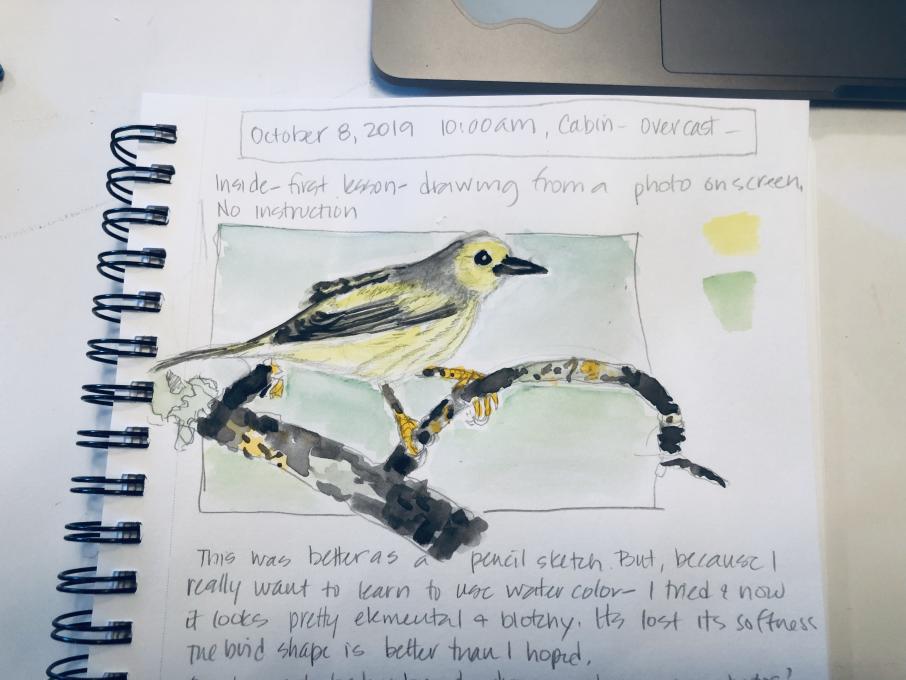 I am more comfortable drawing from a photo than real life. I felt pretty comfortable with my pencil sketch, but as I added watercolor I really felt like I didn't know how to do that.
In a photo you have all the time to go back and see what you might have missed. I finished, and then said, what's in the background, and then did the green wash. However, the photo shows a blurred background, and in nature you would have more detail to chose from.
I am more comfortable drawing from a photo than real life. I felt pretty comfortable with my pencil sketch, but as I added watercolor I really felt like I didn't know how to do that.
In a photo you have all the time to go back and see what you might have missed. I finished, and then said, what's in the background, and then did the green wash. However, the photo shows a blurred background, and in nature you would have more detail to chose from. 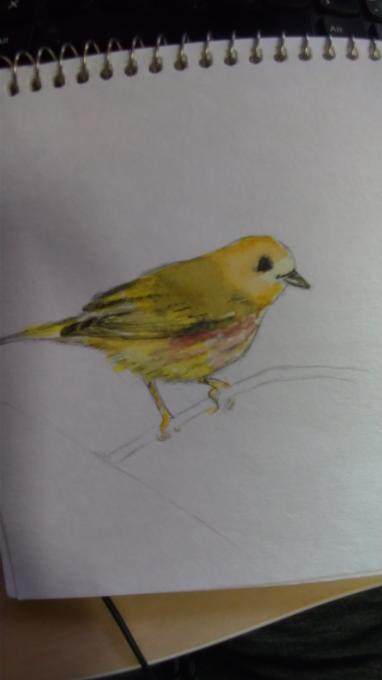
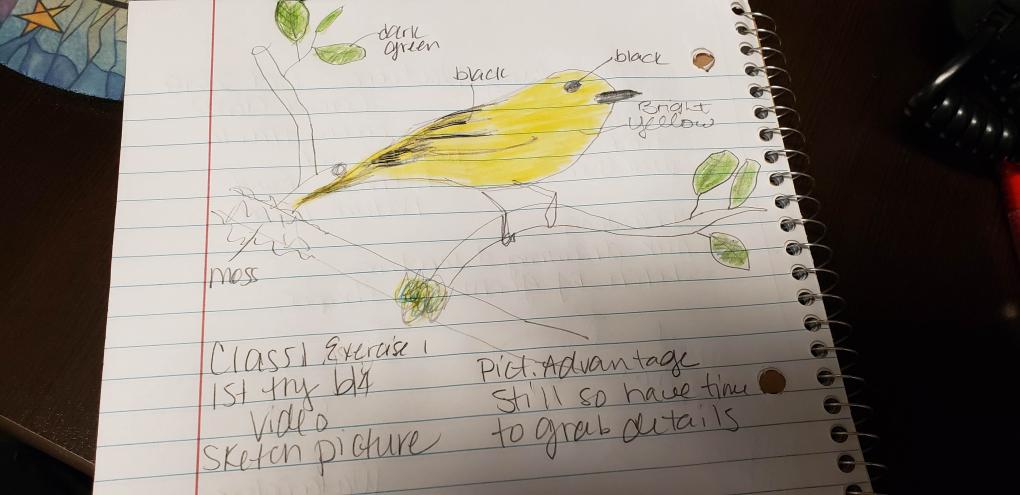

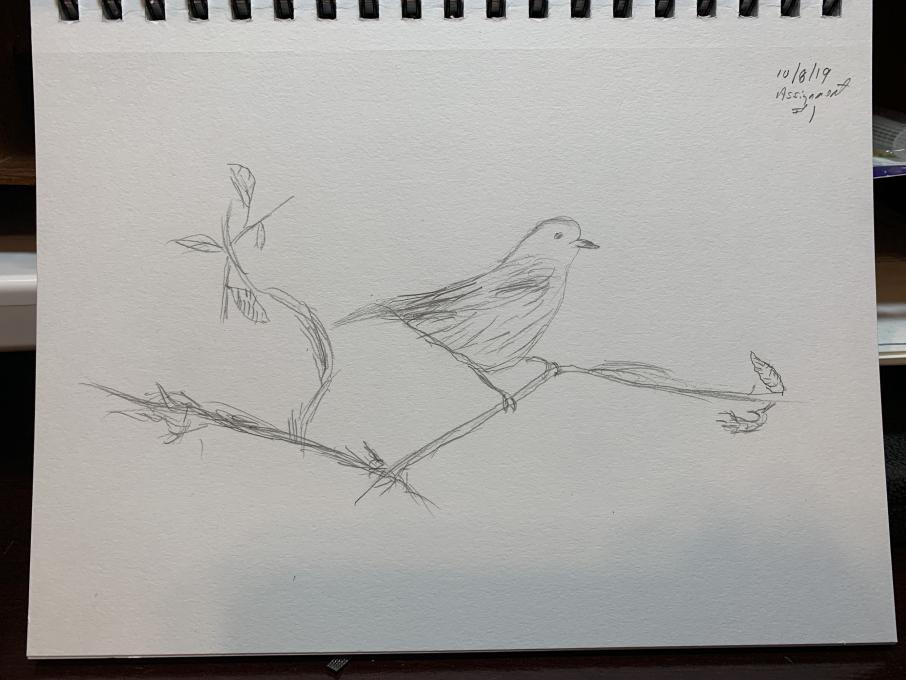
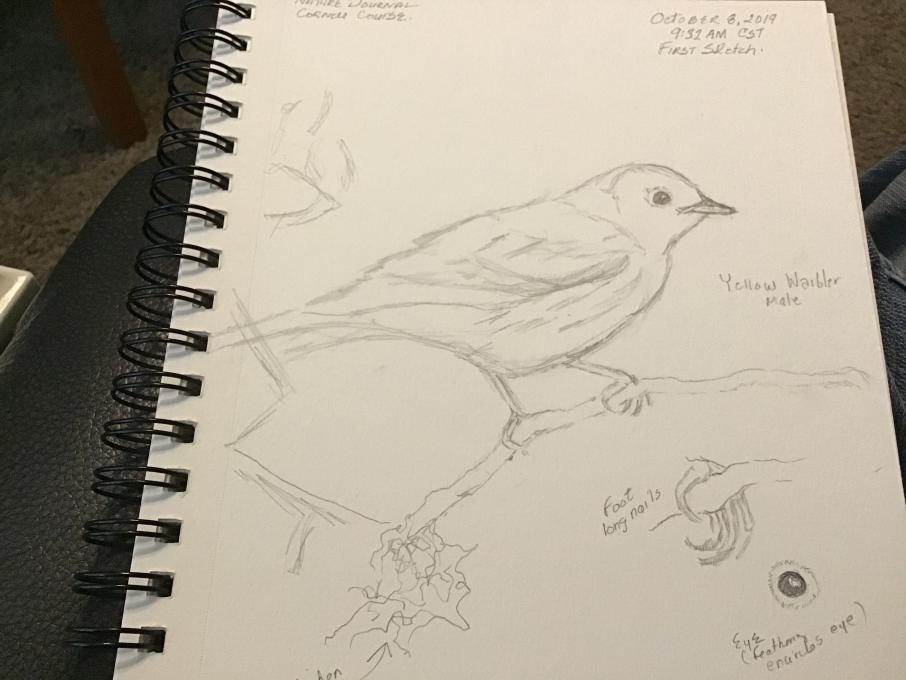 I didn’t mind drawing from a photo, but I tended to do a complete drawing vs a quick impression. I did like being able to enlarge an area of the photo and look at the details. I’d never be able to do that in the field. On the other hand I only had one point of view using the photo. In the field there would be more interplay with light, and field conditions versus a stagnant view. I agree with the poster that suggested putting a time limit on completing the sketch. This is going to be so much fun!!
I didn’t mind drawing from a photo, but I tended to do a complete drawing vs a quick impression. I did like being able to enlarge an area of the photo and look at the details. I’d never be able to do that in the field. On the other hand I only had one point of view using the photo. In the field there would be more interplay with light, and field conditions versus a stagnant view. I agree with the poster that suggested putting a time limit on completing the sketch. This is going to be so much fun!!  I have an old tree similar and I can get the information for a closer look at the actual branch to record a zoomed in section.
The zoomed in portion of the first part of the lesson is something new to me. I love that. I can get a really close look at my tree and make an enlarged drawing of it to add to the drawing.
I have an old tree similar and I can get the information for a closer look at the actual branch to record a zoomed in section.
The zoomed in portion of the first part of the lesson is something new to me. I love that. I can get a really close look at my tree and make an enlarged drawing of it to add to the drawing.
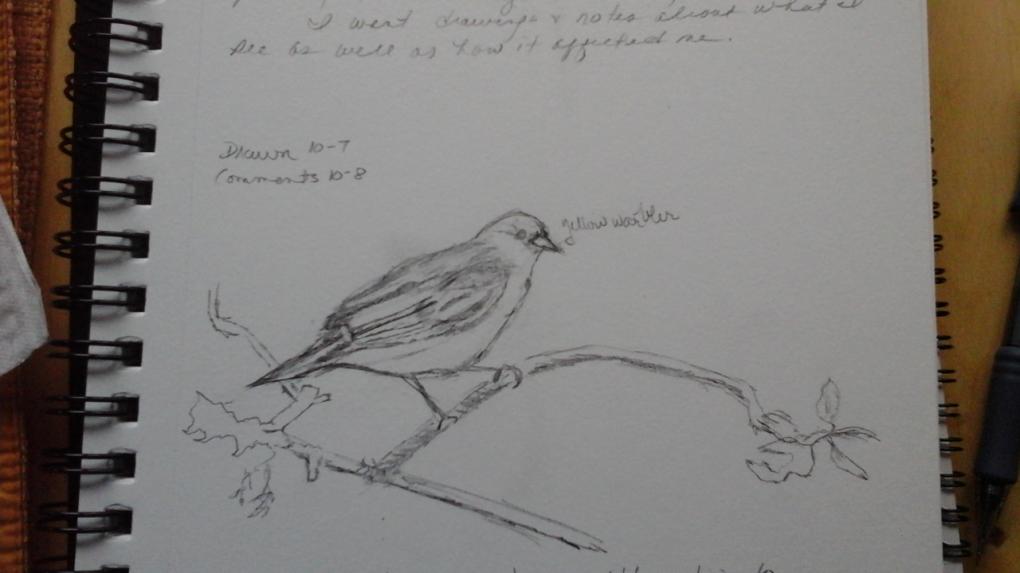




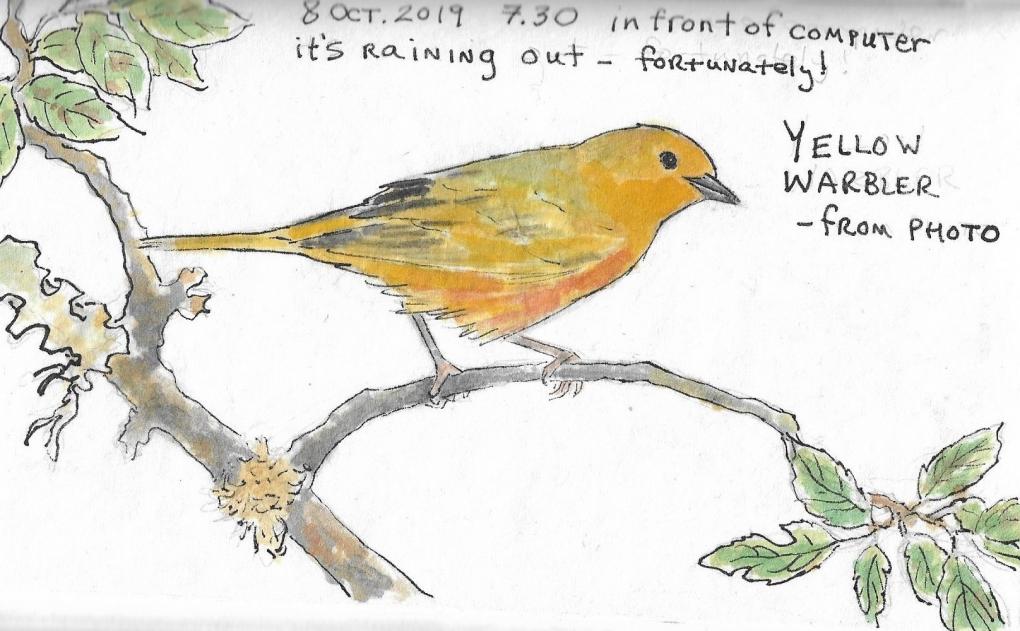
 1) I got a late start on this but wanted to do the assignment, so made a fairly quick sketch. One thing that was hard was to convey the contrast between the soft fluffy looking feathers higher up and the more sharp lines of black in the lower feathers. Also, the angle of the bird was hard to convey: it's head seems turned from position of the lower body. I hope I could have conveyed it better if I'd spent more time, but I wonder if I will have the patience to draw something very detailed.
2) I noticed many details after I started drawing that I hadn't noticed just looking at the photo: the texture of the feathers, the different coloring on different areas, the way the beak attaches to the head, the eye, the claws, the lichen on the branch, etc. etc.
1) I got a late start on this but wanted to do the assignment, so made a fairly quick sketch. One thing that was hard was to convey the contrast between the soft fluffy looking feathers higher up and the more sharp lines of black in the lower feathers. Also, the angle of the bird was hard to convey: it's head seems turned from position of the lower body. I hope I could have conveyed it better if I'd spent more time, but I wonder if I will have the patience to draw something very detailed.
2) I noticed many details after I started drawing that I hadn't noticed just looking at the photo: the texture of the feathers, the different coloring on different areas, the way the beak attaches to the head, the eye, the claws, the lichen on the branch, etc. etc.
 I am so happy to be in this course. Drawing the warbler was so much fun!! I'm a photographer and I'm used to looking at details but I think drawing made me appreciate the gentle sloping lines and shapes even more
I am so happy to be in this course. Drawing the warbler was so much fun!! I'm a photographer and I'm used to looking at details but I think drawing made me appreciate the gentle sloping lines and shapes even more 
 Definitely a plus that it held still. I got lost in the drawing just like I used to, which was really lovely.
Definitely a plus that it held still. I got lost in the drawing just like I used to, which was really lovely. 
 1. it was hard to start the body of the bird on a blank page. Using colored pencils for the first time was a challenge. Nothing was particularly easy. It was difficult making the warbler as beautiful on the page as he was in the photo. My eraser was terrible. Must get a decent one.
1. it was hard to start the body of the bird on a blank page. Using colored pencils for the first time was a challenge. Nothing was particularly easy. It was difficult making the warbler as beautiful on the page as he was in the photo. My eraser was terrible. Must get a decent one. 